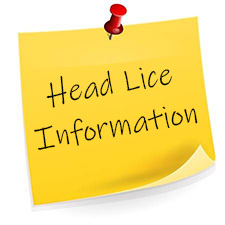Head Lice Information
October 02, 2019
An infestation of head lice can bring on a wide range of emotional responses, ranging from embarrassment to guilt to rage. Parents and caregivers can experience much frustration than can lead to anger and blame, especially toward the school. The facts show head lice to be more of a social issue rather than a serious health concern. Current research indicates that most lice infestations are rarely contracted in the school setting.
Head lice are primarily transmitted by direct head-to-head contact. An example of this would be siblings sharing the same bed and pillow. Hugging and cuddling is also a form of direct contact. Other forms of transmission are less direct, such as sharing of hairbrushes, combs, barrettes, hats, scarves, etc. An infestation of head lice can be symptom free and go undetected for several weeks. Symptoms may include itching, redness, or scratch marks.
Criteria for screening an individual for lice are persistent itching or scratching, known exposure to a sibling or other close contact with head lice (e.g., overnight sleep over, sharing the same locker, etc.), self-referral.
Prevention strategies:
- Students should not pile jackets, scarves, or hats in classrooms, playgrounds, or cafeteria.
- Coats should be hung on separate hooks or in lockers.
- Commercial insecticide sprays should never be used on furniture, mats, or carpeting. Vacuuming or washing with warm water and soap is sufficient.
- Computer headsets should be wiped off with a clean, damp cloth between student uses. The cloth does not have to have chemicals.
- Students should not share helmets.
- Avoid sharing hats, wigs, pillows, stuffed toys, or dress-up clothes.
Treatment:
- Parents of students who are found to have live lice at school will be notified and will be given instructions to treat the student’s hair with a lice-killing shampoo. The parent does not have to immediately pick the student up from school, but they are given that option if they want to begin treatment. Once the student has been treated with a lice-killing agent the student can return to school. They do not have to be free of nits (eggs).
- Daily lice and nit combing should occur at the home for two weeks. Daily head checks of family members should continue until everyone has been clear of lice for 2-3 weeks.
- Use of sprays, fumigating agents, and bug bombs is discouraged. Vacuuming, ironing, clothes drying, and/or bagging items is sufficient.


 Launch the media gallery 1 player
Launch the media gallery 1 player